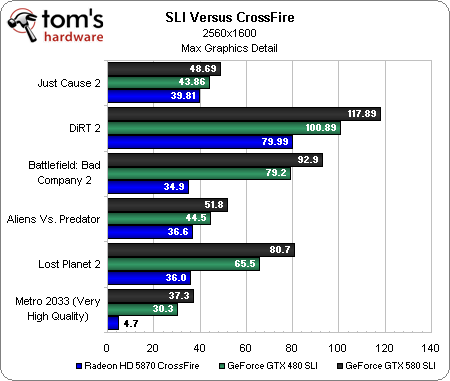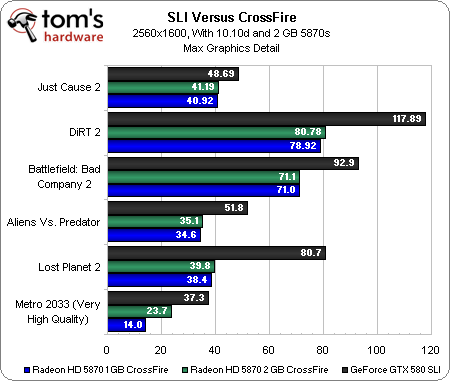GeForce GTX 580 And GF110: The Way Nvidia Meant It To Be Played
After an arguably disappointing GeForce GTX 480 launch back in March, we knew the company had to be working hard on a successor. Meet its flagship GeForce GTX 580, based on the GF110 GPU. This time around, Nvidia proves the idiom "better late than never."
Benchmark Results: SLI
We’ve established on more than one occasion that Nvidia’s scaling in SLI, employing two graphics cards, is superb. That remains the case with its GeForce GTX 580, and we ran each of the games in our benchmark suite just to demonstrate the firepower available through two of these cards.
Each comparison requires a step-by-step explanation because, while we were shooting for the highest settings in each title, AMD’s Radeon HD 5870 doesn’t support all of the same anti-aliasing modes.
In Just Cause 2, with Nvidia’s boards running 32x CSAA and AMD’s employing 8x MSAA, performance is actually fairly close at 2560x1600 with all of the detail settings maxed out. You don’t get a ton of extra performance by switching from GTX 480s to 580s. But the frame rates are generally pretty playable in both cases.
DiRT 2 makes for an easier comparison, as all three configurations are set to 4x MSAA. What you see is what you get. Regardless of whether you’re running a pair of Radeon HD 5870s or GeForce GTX 580s, though, 2560x1600 is easily accessible.
The Radeon cards seem to struggle with 8x MSAA in Battlefield: Bad Company 2 (switching to 4x MSAA yields faster frame rates than both of the GeForce pairs, though). Switching from GeForce GTX 480s to 580s is good for a roughly 17% performance increase here.
With all three combos utilizing 4x MSAA, the comparison is easy in Aliens Versus Predator. A 16% speed-up is about what you can expect after trading your 480s in for 580s.
Lost Planet 2 is almost untestable with 8x MSAA enabled on the Radeon cards, and even 4x MSAA suffers a huge slowdown. With that said, the GeForce boards do fine in this TWIMTBP title, jumping 23% when we switch from GeForce GTX 480s to 580s.
Get Tom's Hardware's best news and in-depth reviews, straight to your inbox.
The highest you can crank Metro 2033 is 4x MSAA. But even then, this game brings AMD’s boards to their knees with its Very High quality setting. If we weren’t so suspect of the optimizations made in favor of Nvidia, we’d label this game the new Crysis and add it to our benchmark suite for the next three years (kidding). Here again, frame buffer limitations on the AMD cards are hurting performance, giving the larger 1.5 GB repository on each GeForce board a marked advantage at the resolutions you'd want to use if you had a pair of these pricey boards.
Evening Out The Score
It is worth noting that AMD's recent Catalyst Hotfix 10.10d does include some optimizations for CrossFire in a number of different games. Only one (Metro) is represented in our suite, though. Testing that title with the hotfix increases frame rates from 4.7 FPS to 14.0 FPS on our Radeon HD 5870 1 GB CrossFire configuration. The new number is still not playable, but it's a significant improvement.
You can further improve performance in frame buffer-limited situations by shifting away from the 1 GB 5870s and toward the 2 GB cards, working around the ceiling imposed by high resolutions and extreme multi-sample anti-aliasing. Using a pair of Radeon HD 5870 2 GB boards, performance in Metro 2033 increased even more to 23.67 frames per second. Of course, now you're looking at an additional ~$50 per board, increasing the cost of two 5870s considerably without exceeding the performance of two GeForce GTX 480s.
The only other title to see a significant gain here (compared to the first graph on this page) is Battlefield: Bad Company 2, though this seems to be a result of the CrossFire hotfix, not the extra 1 GB of memory per card. For the most part, spending more on the 2 GB boards won't really help out that much.
Current page: Benchmark Results: SLI
Prev Page Benchmark Results: Adobe Premiere Pro CS5 Next Page Benchmark Results: Power And Heat-
KT_WASP The last bit of the article is the most important I think. Anyone who drops $500 on this card right now, before Cayman releases, should have their head examined. With two companies releasing so close together, it would be in a person's best interest to see what the other is bringing to the table before shelling out such a large chunk of change.Reply
If the 6850 and 6870 have shown one thing.. they are much better then the last gen in many ways (power, noise and scaling) and the cayman is much more robust then the barts. So, before you start calling a winner here, wait and see. That is my advise. -
awood28211 Sound performance but the game here seems to be...double leap-frog. You can just release a product that competes with the competitors current offerings, you gotta compete with what he releases next... If AMD's next offering is significantly faster than it's current, then NVIDIA will still be playing catchup.Reply -
Wheat_Thins Kinda pointless article other then the fact that the 580 offers superb performance but until I see power and noise set in stone I honestly don't care.Reply
A single GPU nearly outperforming a 5970 is quite a statement. Wonder if AMD has what it takes to answer this as the 6850 IMPO is pretty disappointing other then the price. -
nevertell So it's basically what the 480 should have been. Fair enough, I'll wait for the 470 version of the gf110 and buy that.Reply -
TheRockMonsi The price right now for this card is way over $500 on newegg. For that price NVIDIA better be giving me a bj as well.Reply -
It'll certainly be interesting, even if i don't agree with NVIDIA playing catchup. The 480 had its flaws, but it still was the fastest single GPU around.Reply
We'll see what the 69xx have to offer. NVIDIA releasing now puts somewhat of a time constraint on AMD though. If it takes them too long to get something out the door, even some people waiting now may just get the 580 for christmas. -
kevin1212 Nvidia is embarrassed by the power draw of the gtx 580, haha. Improvement in performance but uses the same amt of power... still not a big enough improvement in efficiency, and no big leap in value either. AMD will wipe the floor with this card.Reply
By the way, i know you guys decided to drop crysis, and i can understand that, but given that this is a high end card, maybe you should have considered it, since frankly anyone buying a card like this would probably want it for crysis more than anything else. A 6870 is more than enough for the others. -
iamtheking123 Looks to me that the 580 is somewhere between a 5870 and a 5970. Might have been more impressive if it was Q2 2010 and not Q4 2010.Reply
With ATI's meat-and-gravy bits of the 6000 series on the launchpad, you'd be an idiot to buy one of these at this price.


